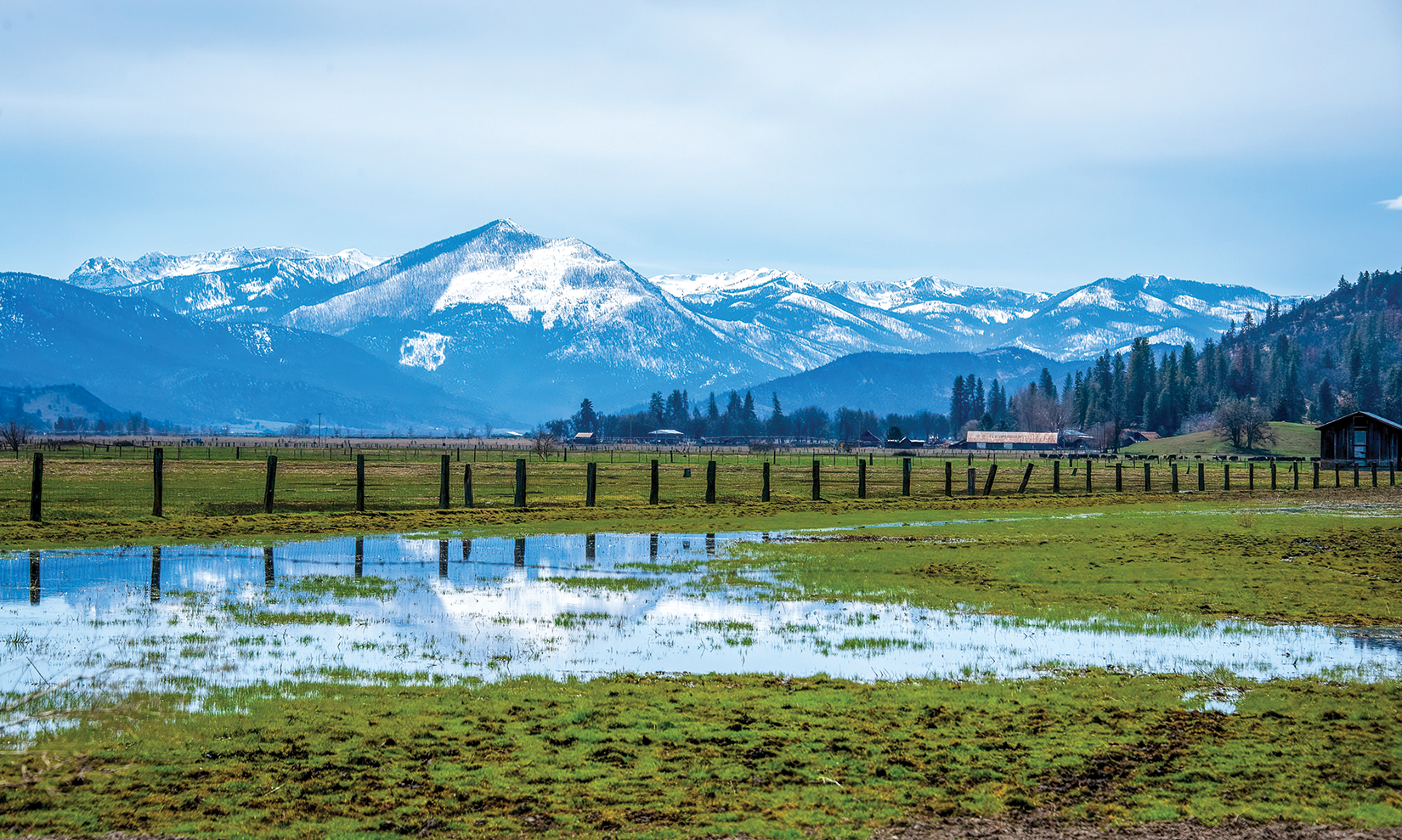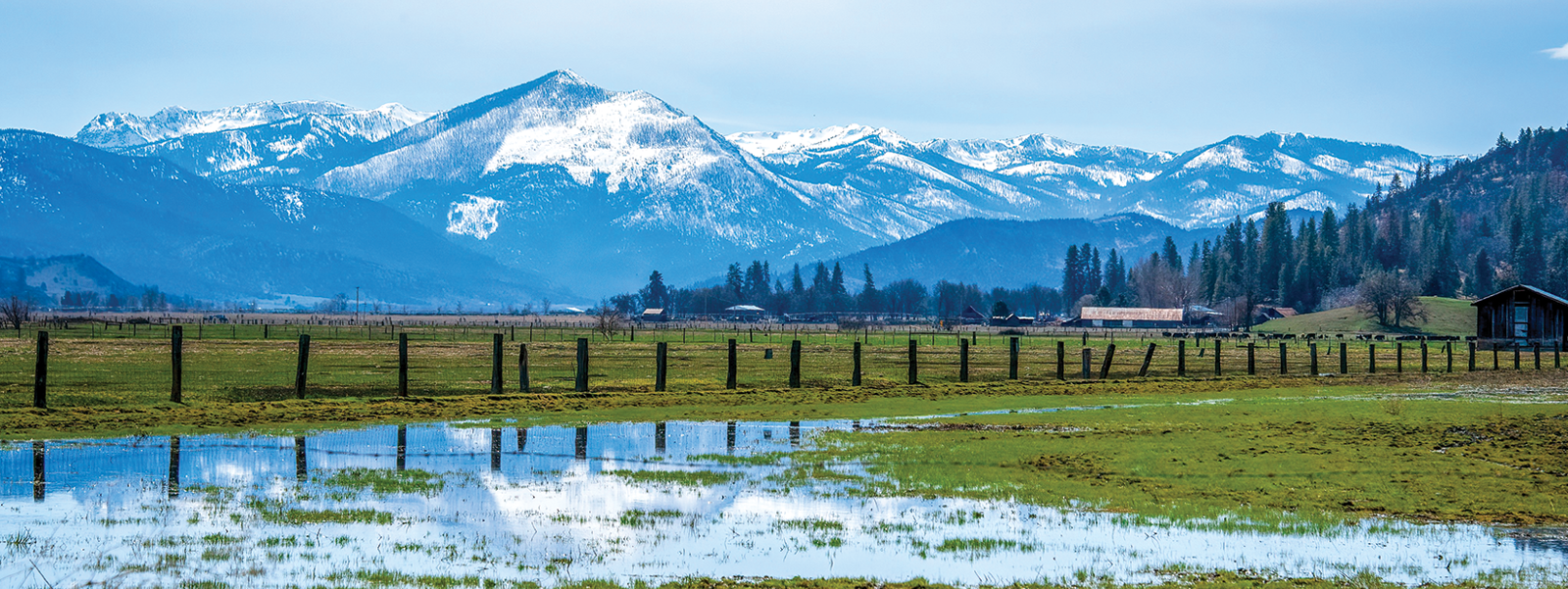Despite storms, farmers still face water supply cuts

The Scott Valley, as photographed on April 3, was soaked with rain from recent storms, with snow in the nearby Trinity Alps. The region remains under water-curtailment orders.
Photo/Mel Fechter

By Christine Souza
Farmers with water rights along the Scott River and Shasta River watersheds in Siskiyou County have faced curtailments of surface and groundwater supplies since 2021, as a result of state actions spurred by a drought emergency declaration by Gov. Gavin Newsom.
After atmospheric rainstorms and heavy snowfall dramatically increased snowpack and reservoir levels this year, a March 23 executive order by the governor temporarily suspended drought curtailment orders for some watersheds. But the regulation remains for the Scott River and Shasta River watershed, frustrating some water users in the Northern California agricultural region.
The California State Water Resources Control Board updates the orders based on weather and hydrology. The order was suspended until April 30 for the Shasta River. For the Scott River, temporary suspension of the order is expected to continue through May 2, water board officials said.
Staff from the board’s Division of Water Rights provided a statement in response to questions from Ag Alert®: “While this winter has been above average for the area,” the statement said, “it is not record-setting, and these are flashy systems that behave differently from the Russian River and Delta systems.”
While officials said the region is in a moderate drought according to the U.S. Drought Monitor, locals point to the area’s above-average snowpack, which measured more than 160% of average on April 1. Snowpack is the primary source of water in the Scott River, while springs drive the Shasta River system.
“There seems to be this misperception at the water board that the Scott Valley and Shasta Valley are still in a drought, but the numbers suggest that we are not in a drought year this year,” said Siskiyou County rancher Ryan Walker, president of the county’s Farm Bureau. “Most hopeful would be that the governor will rescind the emergency order for the Scott and Shasta. I think we are owed an explanation of what it is going to take to get us out of this.
“If this wasn’t the year that gets us out of that declaration, what does the right year look like?” Walker asked.
The regulation curtails surface-water diversions and groundwater pumping and prioritizes minimum flows to protect threatened coho and other fish. The order halts water diversions whenever a monthly minimum-flow target is not met for each watershed. Water users who participate in a voluntary program must reduce groundwater pumping by 30%. Otherwise, all water users will be curtailed once flows drop below required levels. The regulation also prohibits the use of stock water systems that use unlined ditches.
Those affected by another year of potential water cutbacks, which have led to fallowed acres and economic impacts to communities, are not pleased. They are still under the emergency curtailment order, Walker said. He said it seems that state water officials keep moving the goalposts for lifting curtailment orders. “No matter what the hydrology does, there’s going to be some reason that we have to be under some sort of emergency order,” Walker said.
“We’re clearly facing some type of flow regime into the future,” he added. “The governor’s emergency order makes clear their unwillingness to acknowledge reality and say we have a wet year, and continue to hold that power. If that’s the world we’re going to live in, where we have to live with minimum flows, we need to find a way to achieve those flows.”
In speaking before the state water board on April 4, Sari Sommarstrom, a retired watershed consultant in the Scott Valley community of Etna, called the board’s policy inconsistent and unjustified.
“While the Sacramento River basin is also in the D-1 (moderate drought) category, that region was included in the governor’s rollback” of water curtailments, said Sommarstrom, a founder of the Scott Valley Agriculture Water Alliance. “Our region is not having a wet water year but is moving into an above-average water year. This improvement in hydrologic conditions should be recognized by the state board, especially regarding its emergency drought regulations.”
She and others representing the region point to pressure from the fish advocacy community to make instream flow requirements permanent. Sommarstrom said she agrees with the Scott Valley and Shasta Valley Watermaster District’s position that strategic use of water and flow timing is needed to protect fish and farms alike.
“More flexibility is needed in the regulation,” Sommarstrom said, adding that about half of Scott Valley’s irrigated lands—15,000 acres—could be fallowed by this summer, since areas using only surface water will be 100% curtailed once minimum flows are not met.
She also told the board that the 2020 Scott River coho spawning run of 1,766 adults was the second highest on record. “This coho brood year endured these past two years under severe drought conditions, yet the population thrived before the state water curtailment’s cutoff of irrigation water occurred, showing that the Scott River’s habitat can successfully produce more coho without such state interference,” Sommarstrom said.
Scott Valley rancher Theodora Johnson said the regulation is unfair due to its “unreasonable expectations.”
“The regulation mandated untenable summer flow standards that almost guaranteed curtailments for us,” said Johnson, a founder of the Scott Valley Agriculture Water Alliance. “The Scott River hasn’t met those summer flow requirements in 10 out of the past 12 years, so even in a normal-to-good water year like we appear to be having, we are still afraid we won’t meet the flow standards this summer.”
Prohibiting ranchers from keeping stock water in ditches between September through March limits how much water livestock can drink and prevents farmers from the benefit of groundwater recharge in the winter, Johnson said.
E. Joaquin Esquivel, chair of the state water board, acknowleged the frustrations in the region. Responding to comments from residents, he said, “Know that we’re always looking to balance, and we’ll have an opportunity in some future item to unpack further many points that you’ve made.”
In statements to Ag Alert®, staff in the Water Rights Division said it is “actively evaluating” the situation in the Scott and Shasta rivers and potential next steps. Staff noted the watershed has experienced impacts from three of the driest years on record, describing coho salmon returns as “very poor.”
Speaking to the state’s role in balancing the uses of water, Chris Scheuring, senior counsel for the California Farm Bureau, said the state needs “a workable solution for Californians—for people and the environment.”
“California must consider the environmental landscape and the human economy, and must contend with limited water resources, and so, curtailments, like everything else, have to be underpinned by solid technical data and solid science,” Scheuring said.
The governor’s May 23 executive order ended direction to pursue emergency regulation renewals in the Russian River and the Sacramento-San Joaquin River Delta watershed but called for maintaining orders for the Klamath River watershed.
Water board staff said there will be a public comment opportunity on the Scott and Shasta rivers in coming weeks. The emergency regulation expires Aug. 8.
(Christine Souza is an assistant editor of Ag Alert. She may be contacted at csouza@cfbf.com.)




